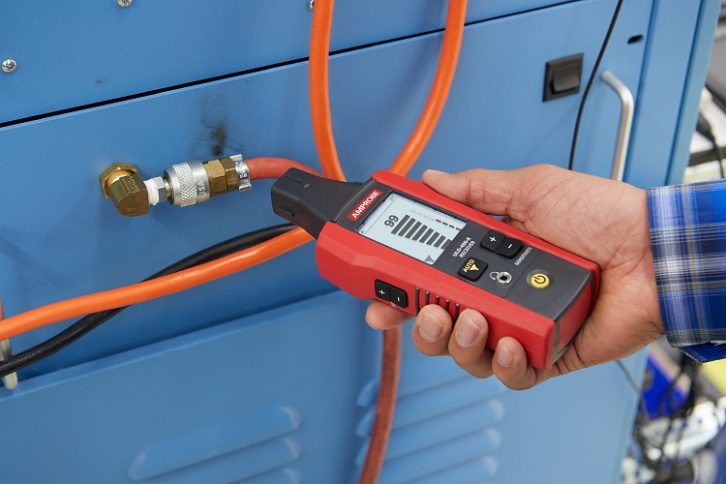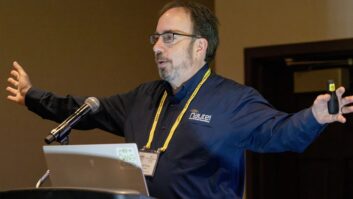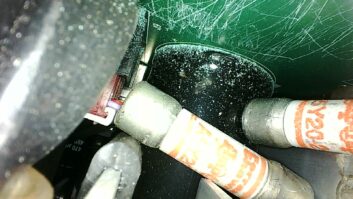This time he has come across a very interesting audio clip on YouTube. “Nickd2011” took an MP3 recording of Michael Bolton’s “How Am I Supposed to Live Without You” and compressed it up to 300 times.
Nick reminds us that every time an MP3 is recompressed, some of the audio is thrown away. In his example, Nick opened a FLAC file of the song in Adobe Audition, then saved it as a 128k MP3.
He then opened the MP3 he just saved, and resaved it as a 128k MP3 with a new file name. Nick repeated that process 300 times.
When you listen to the fifth generation you’ll notice artifacts in the audio. By the 10th, the audio sounds terrible. And with each subsequent compression, the audio quality only gets worse.
Nick compares the degradation to the game of “Telephone” in which a large group of people line up and the first person whispers something to the second person, who whispers it to the third and so on. By the time the message gets to the last person, the meaning would have changed.
A similar process happens when an MP3 file gets compressed over and over. Each generation introduces new artifacts in the audio, as the decoder imperfectly approximates what audio was thrown away. Wait till you hear the 300th generation!
This is a great clip to share with your programming folks. Find it here.
Sniffing for leaks
Amprobe probably is most familiar to broadcast engineers for its line of clamp-on ammeters the company builds. Their innovation doesn’t stop there, however.
The company has developed an ultrasonic leak detector to help troubleshoot leaks. Initially designed for air conditioning technicians, this probe also can be used to sense nitrogen or other gas leaks in pressurized transmission line.

The ULD-420 has a frequency range from 20 kHz to 90 kHz, the optimal range for detecting a variety of leaks. Three switchable filters help remove noise frequencies in noisy environments, and a headphone output is provided.
The tool runs about $1,000 on Amazon, so it may be better suited for group broadcaster purchase. You can find out more at the Amprobe website www.amprobe.com.
Coming up the end of this month, Amprobe is sponsoring a webinar on using the ULD-420 for leak detection. Register at www.amprobe.com/webinars.
Tiny bubbles
Looking for a less expensive means of leak detection? Radio World Technical Advisor and veteran engineer Tom McGinley reminded me of a simpler method: a bottle of soapsuds.
Even dishwashing liquid cut with water will work. Put it in a spray bottle and spray your connections and junctions of nitrogen tubing with the soapy water. If there’s a leak, little bubbles will appear at the leaky junction. Wipe the water off and tighten the connection.
Help the next engineer
I just presented a Generator Maintenance program for members of the SBE Mentor Program, which is designed to help broadcast engineers new to the field by partnering them with seasoned professionals. The goal is for the more-experienced person to share his or her gained knowledge, both empirical and practical, with someone new to the field.
Mentor Committee Chairman Chris Tarr says, “For the seasoned mentor, it’s a chance to give something back. For the freshman mentee, it’s an ideal way to gain inside knowledge and understanding that can sometime take years to accumulate.”
Program participants also are invited to join the SBE Mentor Group on the SBE Facebook page. This is a member-only benefit. Mentor program participants also receive monthly newsletters and have access to a special Mentor program quarterly webinar series.
Interested in learning more? Contact Education Director Cathy Orosz at [email protected] or 317-846-9000.
We’re hooked!
 BGS Sales Associate Mary Schnelle sent us this photo. It’s a view of the underside of an interview table installed at WTOP in Washington by Rob Goldberg and RadioDNA last fall.
BGS Sales Associate Mary Schnelle sent us this photo. It’s a view of the underside of an interview table installed at WTOP in Washington by Rob Goldberg and RadioDNA last fall.
Just a simple hook intended for holding headphones. The hook quickly morphed into another use as a place for guests to hang their purses (or murses). Off the floor and easily within reach!
John Bisset has spent over 50 years in the broadcasting industry and is still learning. He handles western U.S. radio sales for the Telos Alliance. He holds CPBE certification with the Society of Broadcast Engineers and is a past recipient of the SBE’s Educator of the Year Award. Workbench submissions are encouraged, qualify for SBE Recertification, and can be emailed to [email protected].







